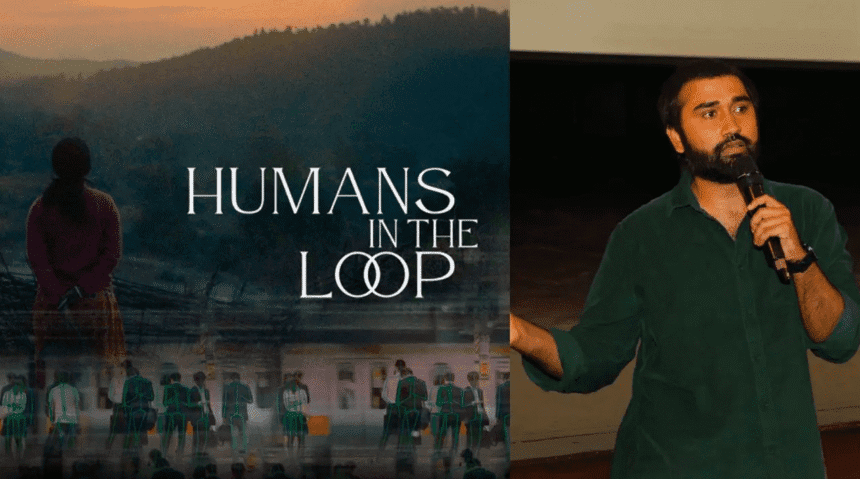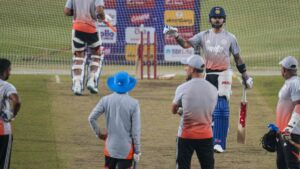In a pivotal moment from Humans in the Loop, Nehma’s supervisor challenges her classification of a worm as a pest. Nehma responds with poise, clarifying that the worm only consumes the decomposed sections of the leaf, enabling the plant’s survival. She emphasizes that artificial intelligence, akin to a child, learns based on what it is taught. The supervisor dismisses her perspective, contending that the client’s designation as a pest requires her compliance. This exchange encapsulates the conflict between Indigenous knowledge and AI logic, illustrating the themes that filmmaker Aranya Sahay explores in his debut feature, which reflects his background in a sociologist’s home and his experiences within Adivasi communities.
In an interview with Maktoob Movies’ Ashikha N, Sahay addresses central themes of his film.
“Ashikha N: Throughout the film, the metaphor of AI as a child reemerges in the context of its education. Was this always a focal point in your script, or did it develop later?”
“Aranya Sahay: The AI metaphor emerged after about a month of exploring the premise of Adivasi women interacting with AI. I initially considered various subjects, such as content moderation, where data labelers repeatedly view violent imagery. However, I sensed a deeper exploration was needed. As I analyzed data labeling more closely, I observed its resemblance to parenting — teaching children to differentiate objects and, by extension, our way of life. This connection sparked the idea of viewing AI as a child, which opened up numerous possibilities for the narrative.”
“Ashikha N: You’ve mentioned the impact of your mother’s work as a sociologist with tribal communities. How did this influence your vision for the film?”
“Aranya Sahay: My mother’s work significantly shaped my perspective. Growing up in a sociological environment, I absorbed concepts almost unconsciously. One idea that resonated with me is that of totems, which are integral to Indigenous culture. This understanding has profoundly influenced my storytelling and symbolism, evident in the film’s inclusion of the porcupine.”
“Ashikha N: The stark visual contrast between the sterile data-labelling center and the rich textures of nature is striking. Did this concept evolve with your cinematographers?”
“Aranya Sahay: The visual aspects of the film stemmed from the writing and researching the setting. The contrast reflects Nehma’s emotional state, with warmer lighting in her initial curiosity that shifts to a colder tone as the narrative progresses. The film’s visual design was a collaborative effort with my cinematographers, who suggested locations that enhanced the film’s texture, such as the Bar Council of Ranchi.”
“Ashikha N: What was your preparation and research process like for your debut?”
“Aranya Sahay: Preparation was immensely enjoyable. I find fulfillment in grounding myself in the details of a place, learning about its communities, and engaging in dialogue. This research enriches the film’s narrative, imbuing it with the poetry of its environment.”
“Ashikha N: Were there elements that didn’t make it into the film but influenced your vision?”
“Aranya Sahay: There was a beautiful creation myth about an earthworm that I couldn’t incorporate. It narrates how the earthworm brought soil from the ocean’s depths to create land. I had hoped to weave it into a key sequence, but ultimately had to prioritize the film’s pacing.”
“Ashikha N: The film uses both Hindi and Kurukh. Why was it important to retain both languages?”
“Aranya Sahay: Making the film bilingual was crucial because Hindi is widely spoken in the region. Production realities dictated the use of Hindi in some instances for practicality while maintaining authenticity through Kurukh where it mattered.”
“Ashikha N: As a co-editor, how do you view editing as part of your voice as a filmmaker?”
“Aranya Sahay: Editing is essential; it’s where the film truly comes to life. My editor and I shared a collaborative relationship, allowing us to approach the material with objectivity and trust.”
“Ashikha N: Your film highlights how Indigenous wisdom often emphasizes observation and interconnection, contrasting with corporate AI frameworks. How did you arrive at this perspective?”
“Aranya Sahay: My writing was informed by conversations with Indigenous women. Through these dialogues, I encountered profound insights about patience and relationship with the land, shaping the film’s sensibility.”
“Ashikha N: Nehma’s refusal to label the worm as a pest appears to be an ethical stance. How did you incorporate her caste and marital status into the story?”
“Aranya Sahay: While I don’t see it as a question of caste, I aimed to illustrate how biases influence AI. Nehma’s marital status creates a significant lens for exploring her eventual liberation, which is crucial for her character development.”
“Ashikha N: The performances of the supporting characters felt genuine. Can you elaborate on the casting process?”
“Aranya Sahay: Eleven of the thirteen actors, including youth from the village, are from Jharkhand. Their naturalness helped create an authentic atmosphere. I workshopped with them to ensure they understood the rhythm of the scenes.”
“Ashikha N: Independent cinema in India faces challenges with distribution. Reflect on your journey with Humans in the Loop.”
“Aranya Sahay: Indeed, independent cinema struggles with distribution, which was a considerable effort over the past year. We screened the film nationwide in a bid to raise awareness. Kiran Rao’s involvement as executive producer following a grassroots screening was a rewarding culmination of our collective efforts.”
“Ashikha N: With AI viewed as ‘humanity’s child,’ how do you perceive our current approach to parenting it?”
“Aranya Sahay: Our actions reflect the best and worst of humanity. AI mirrors us, learning from our biases as well as our compassion. It evolves alongside our contradictions, encompassing both our flaws and virtues.”
“Ashikha N: The mother-daughter dynamics between Nehma and Dhaanu resonate with intergenerational conflict. Did you draw on personal experiences?”
“Aranya Sahay: Yes, I drew from my own conflicts. The final scene embodies a wishful apology, which might not occur in reality but expresses a longing for reconciliation. Such moments capture the essence of healing.”
Humans in the Loop recently won Best Narrative Feature (Audience Choice Award) and Best Actor – Female at the Tasveer Film Festival in Seattle. Following its critical acclaim at various film festivals and screenings, the film is set for release on OTT platforms.
Tags: indigenous perspective, Aranya Sahay, Humans in the Loop, conversation, cultural insights
Hashtags: #indigenous #conversation #Humans #Loop #director #Aranya #Sahay










